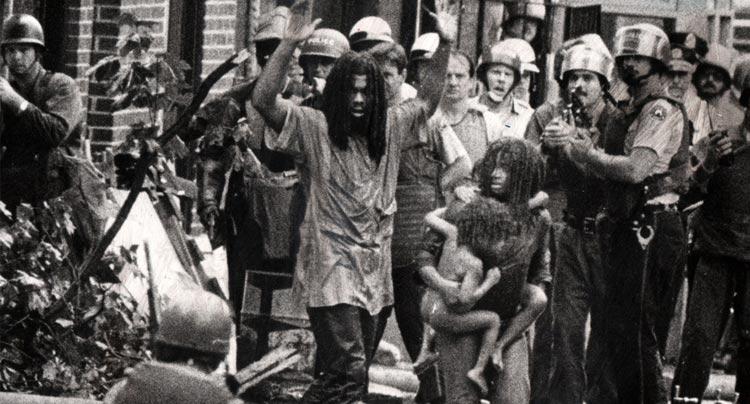
Impossible to keep your eyes off of, one of the most effective documentaries this year.

Impossible to keep your eyes off of, one of the most effective documentaries this year.
In Jason Osder’s bleak, infuriating documentary Let The Fire Burn there’s a feeling of amazement at what he and editor Nels Bangerter have achieved through their self-imposed limitations. The subject matter, a long battle between the City of Philadelphia and a radical urban group that eventually came to a tragic end, relies entirely on archival footage. The amount of footage Osder and Bangerter had to work with appears to be massive, and the fact that they have compiled something so cinematic and effective is an achievement.
The central event in Let The Fire Burn took place on May 13, 1985. After years of tension between MOVE, a communal group that rejected technology along with being described as a cult, and the city’s police force things came to a devastating end when the city dropped C4 explosives on MOVE headquarters. 11 people were killed, and the resulting fire destroyed over 60 surrounding homes. Osder uses footage of the city’s investigation after the incident, relying on testimonies from all of the major figures to provide context and backstory for everything leading up to the bombing. What emerges is a riveting document of a seemingly little-known tragedy in American history.
The footage of the investigation is combined with footage from other sources. The taped deposition of 13-year-old Michael Ward, one of the only survivors from the explosion, serves as the other major piece of footage used throughout the film. The multiple testimonies act as narration for newsreels, old documentaries, home videos, and other sources of video. As much as the investigation feels like it stays in the background, at times the footage will snap into the forefront. Most of these highlights come from former MOVE member Louise James, who angrily goes after the investigation committee for their questioning.

Moments like this are why Osder’s decision to forego any present-day footage was entirely appropriate. The timing of the commission’s investigation came shortly after the attack on MOVE, meaning emotions ran high during the questionings. This gives the film a level of immediacy that makes it feel in the present. The lack of public awareness (I admit that I had no knowledge of MOVE or what happened before watching) also helps create a larger emotional impact, and Osder’s use of such raw footage makes his film feel simultaneously retrospective and in the present.
And in a similarly contradictory sense, despite feeling so immediate, Let The Fire Burn is constantly making viewers aware of its place in history. The old video of the investigation, in all its fuzziness and datedness, getting stitched together with other low quality sources makes the film feel stitched together. The use of VHS tracking at different points throughout only enforce the feeling of someone splicing all this footage together. That, coupled with the fact that this is a lesser-known part of recent American history, make Let the Fire Burn a real-life found footage film.
Osder is thankfully level-headed about what happened, highlighting the tragedy of what happened while pointing out problems with both sides. Naturally the blame is placed higher on the city, but MOVE is shown to have its issues. Most notable is a scene from a documentary about the group, where scenes of the member’s children imply neglect and starvation. In the end, Let The Fire Burn powerfully shows a situation that was seemingly doomed to end in tragedy. Osder’s technique makes this a film that’s impossible to keep your eyes off of, and makes for one of the most effective documentaries to come out this year.